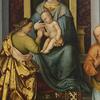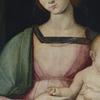Until 6 November: The Travels and Encounters of a Forgotten Artist. Francesco Verla and the Renaissance

This is the first exhibition dedicated to one of the leading players in the Renaissance movement in Trentino: Francesco Verla (1470 - 1521).
Born near Vicenza, Verla’s career led him to travel around the country, taking him in the early years of the 16th century first to Umbria, where he met the great Pietro Perugino, and then to Rome, governed by Pope Alexander VI, formerly Roderigo Borgia. Here he studied classical art and the ruins of Nero’s palace, the famous Domus Aurea, discovering a decorative style incorporating “grotesque” motifs – then in the height of fashion. These experiences were carved indelibly into his memory and the painter from Vicenza was one of the first to bring a style combining delicate pious figures framed by extravagant bizarre motifs north of the River Po, clearly distinguishing himself from his contemporaries.
Returning to his homeland, Verla soon established himself as one of the most popular painters in Vicenza, working on the site emblematic of the Renaissance era in the city, the church of San Bartolomeo, unfortunately destroyed in the 19th century. A magnificent large altarpiece painted for a chapel in this building has been identified and will be on display in the exhibition.
The degeneration of the political situation, which saw Vicenza heavily involved in the war between the Venetian Republic and the Hapsburg Empire, drove the painter to move first to Schio, where he left one of his most inspired paintings (this too on display in the exhibition), and then to Trentino in 1513. He remained in our region for several years, working in the Bishop’s city, but also in Terlago, Seregnano, Calliano, Mori and Rovereto, where he took up residence, dying at an early age in 1521. In a land still steeped in Gothic imagery, Francesco Verla was a trailblazer for the profound cultural and artistic renewal that was shortly to take place with such admirable results thanks to the patronage of Prince Bishop Bernardo Cles.
The painter’s talent has long been unrecognised, due to the loss of many of his works, the subsequent arrival of artists of the highest calibre such as Romanino, Dosso Dossi and Marcello Fogolino at the court of Cles, and a certain embarrassment among critics when faced with his diversity compared to contemporary painters in the Veneto region. For the public today, Verla is thus a ‘forgotten’ artist. Hence the urgent need to rediscover him and reassess his role as a forerunner of the Renaissance in the Adige valley and alpine area.
The exhibition, which takes place fifty years after publication of the only volume dedicated exclusively to Francesco Verla (Lionello Puppi, 1967), concludes a complex research programme developed in collaboration with the Department of Arts and Philosophy at the University of Trento. The work has led to the discovery of much unpublished data, new attributions and documents unknown to date, filling in some significant gaps in our knowledge of the artist and his time.
In the spaces of the Diocesan Museum it will be possible to see most of Verla’s works, brought together for the occasion: from mellifluous altarpieces inspired by the “angelic and gentle air of Perugino” to friezes with grotesque motifs, in which he specialised. The exhibition will also expand to include other sites in the area, with the fresco cycles in the church of San Pantaleone in Terlago and on the façade of Casa Wetterstetter in Calliano.
Source: www.museodiocesanotridentino.it




